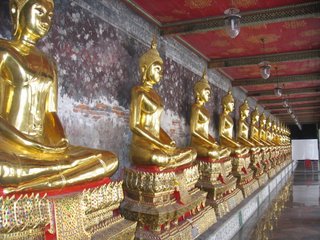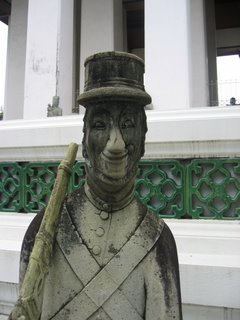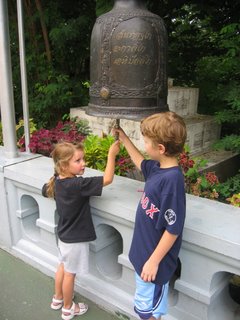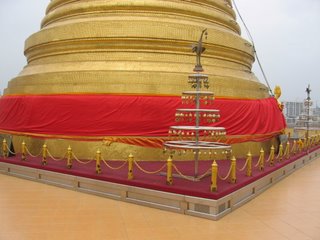I had some down time last week before we moved to our new house, so I decided to visit a few more temples, the first being Wat Suthat.

This is a significant temple because it's the home of Thailand's largest and earliest cast bronze Buddha statue.

It is also the place where you can find Bangkok's tallest viharn (religious hall), and of course, there are plenty other Buddha images as well:

Another unique feature here are the carved wood door panels on the main entrance. They are said to be the work of King Rama II, thus they are valued deeply by native Thais.

In addition, the ashes of Rama VIII (the current King's older brother) are buried in the base of the main Buddha image.
Wat Suthat had a few unique features that I haven't yet seen at the other wats I've visited, including a statue of a very skinny Buddha:

Painted wooden monks worshiping Buddha in another chapel:

And what appears to be happy sailors guarding the exterior of another building (the others usually have soldiers or warriors).



Outside of the temple complex are the remains of the Giant Swing. In a former ceremony to celebrate the rice harvest, men used to swing on it and try to grab bags of money from a pole, but too many of them fell to their deaths. That's why you don't see a swing there, just the arch.

Wat Srakes is another important monastery in Thailand's modern history, but it is completely overshadowed (literally) by the Golden Mount. This giant spire was originally conceived by King Rama III, continued by Rama IV, but not completed until the reign of King Rama V. For that reason, it is considered the most precious property of the Thai nation.

The reason it took so long to complete is that the ground around the whole area was too soft and couldn't bear the weight of the structure. The original structure collapsed and a 262-foot (80-meter) artificial hill was built on top of its remains. King Rama IV himself actually helped lay the stone foundation so that the project could be continued. The area around the ground is now home to a lush garden and cemetary.


A winding staircase that goes around and around the hill takes visitors to the top. Along the way there are many bells and chimes to ring, which makes this a great place to take kids as they are always looking for an excuse to make some extra noise (well at least mine are).


Once you get to the first terrace, you are allowed inside a golden chedi (or pagoda).

You then have to take an extremely narrow staircase (watch your head) to the top of the Golden Mount.



When you finally get to the top pavilion, you have spectacular view of Bangkok and Wat Srakes.

I didn't have time to actually visit the Wat, but I'm sure I will in the future.
Until then...


No comments:
Post a Comment